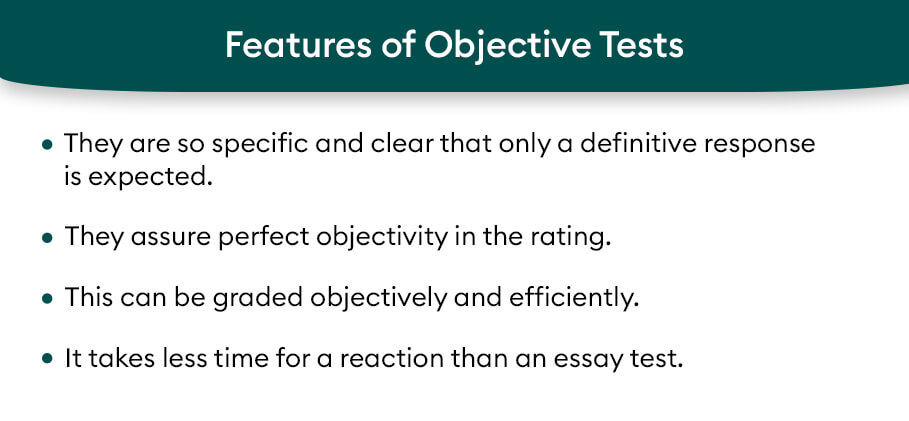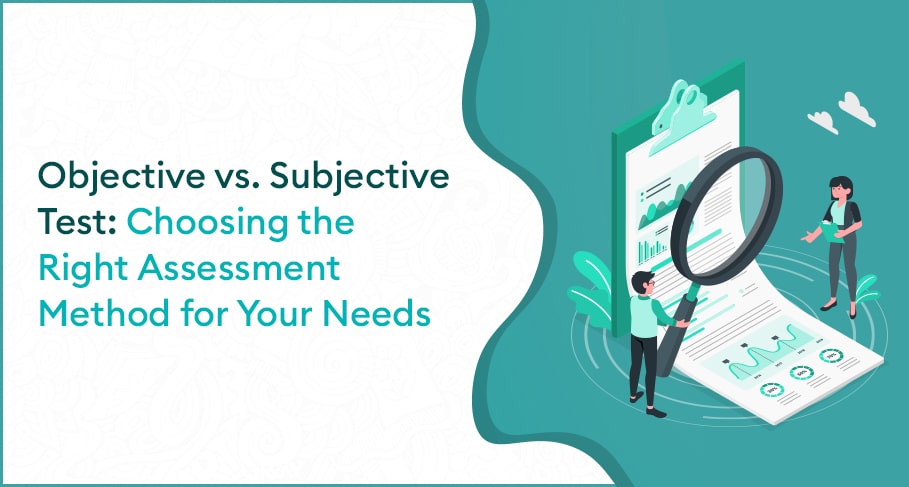Tests are a key tool in education for assessing students’ learning progress and knowledge acquisition. Teachers can employ several types of tests to measure students’ understanding of a topic or subject, ranging from multiple-choice exams to essay questions. One of the most important concerns in education is whether objective or subjective tests are more appropriate for this goal. Objective tests often feature questions with a single correct answer, while subjective assessments encourage students to demonstrate their understanding in their own words. So, Objective vs. Subjective Test, which is the right choice?
In this post, we will look at the strength and limitations of these objective and subjective types of examinations and their impact on teaching and learning.
Let’s look at what they are first:
Objective tests are the most basic assessment methods that feature questions with a single correct response to evaluate foundation and knowledge of the learners.
Objective tests aim to evaluate areas of student achievement that are complex and qualitative, using questions that may have one or more correct answers and may have more than one way of expressing it.
These assessments (either objective or subjective) are often categorized as summative (this form of assessment aims to evaluate student learning at the end of an instructional unit by comparing it against some standard or benchmark) or formative (It monitors student learning to provide ongoing feedback that can be used by instructors to improve their teaching and by students to improve their learning.)
Which is better, Objective or Subjective tests?
Objective Tests
An objective test is a method of evaluation in which questions asked have a single correct answer. Objective questions typically include true/false, multiple choice, and matching questions. Objective assessment is crucial as it can effectively measure each level of a student’s ability, from basic recall to complex synthesis.
It is far more precise, leaving less room for the pupils to interpret hypotheses or concepts. Objective assessment is a method of examination where each question has a single right answer. Subjects that rely largely on objective tests include geography, mathematics, physics, engineering, and computer science.
Types of Objective Tests
- Multiple-Choice
- True/False
- Matching
- Fill in the Blank
- Assertion and Reason
Features of Objectives Tests

Objective testing lends itself to specific tasks since these questions are designed to be answered fast; they also allow teachers to test students on various topics. Furthermore, statistical student, cohort, and question performance analysis are possible.
The ability of objective tests to assess a wide variety of learning is often underestimated. Objective tests examine fact-finding, knowledge, application of terms, and questions requiring short or numerical answers.
One common concern is that objective tests cannot measure learning beyond basic understanding.
However, questions built with imagination can challenge students and test higher levels of learning. For example, students can receive case studies or data collection and be invited to provide analysis by responding to questions.
Problem-solving can also be evaluated with the proper type of questions.
Another concern is that objective tests translate into inflated scores because of conjecture. However, the effects of guessing may be eliminated by a combination of question design and rating techniques. It becomes irrelevant mainly with the right amount of questions and distractions. If not, there is an opportunity to encourage and measure the value of this skill.
There are, however, limitations in what objective tests can assess. They cannot test the ability to communicate, the ability to build arguments, or the ability to give initial responses. Tests must be carefully constructed to avoid the decontextualization of knowledge (Paxton 1998). It is always wise to use objective testing as only one of a variety of assessment methods within a module. However, in times of increasing student numbers and declining resources, objective tests can complement the assessments available to teachers or lecturers.
Strengths of Objective Tests
Reliability: Objective tests are more trustworthy than subjective tests since they do not allow for human bias or interpretation.
Efficiency: Machines can swiftly and efficiently evaluate objective assessments, saving instructors time and effort.
Objectivity: Objective tests provide an accurate and objective assessment of a student’s performance and knowledge.
Validity: When well-designed, objective examinations can accurately evaluate specific knowledge or skills. Objective examinations can be standardized, which means that all students are given the same questions with the same answer alternatives, ensuring fairness and equity in the evaluation process.
Flexibility: Objective assessments can evaluate various information and skills, from basic recall to higher-order thinking abilities.
Limitations of Objective Tests
The higher-order thinking skills evaluation is limited: Objective exams could be more effective in measuring higher-order thinking skills such as critical thinking, problem-solving, and creativity. These abilities necessitate complicated responses that subjective inquiries cannot convey.
Content coverage is limited: Objective tests are only helpful in assessing knowledge that can be quantified and examined objectively. This limits their ability to examine more comprehensive concepts that require interpretation and analysis.
Student attitudes and values are not assessed objectively: Objective tests do not examine attitudes and values, which are vital components of a student’s overall development. They can only assess what pupils know, not how they feel about what they know.
Potential for guessing: Objective examinations are prone to guessing because students can occasionally predict the correct answer by eliminating possibilities or making an educated guess. This can have an impact on the validity of the test results.
Limited Feedback: Objective assessments provide students with limited feedback because they objective assessment reprocess do not let students provide information about the reasons behind the correct answer or how to improve. As a result, pupils may not fully comprehend the material and may be unable to enhance their performance.
Subjective Tests
EnglishPost.org defines “Subjective tests aim to assess areas of students’ performance that are complex and qualitative, using questions which may have more than one correct answer or more ways to express it.” Subjective assessments are popular because they typically take less time for teachers to develop and allow students to be creative or critical in constructing their answers.
Simply put, a subjective test is one in which the answer is not customarily predefined. A subjective test is assessed via an opinion. Also, students must assess their intended audience when preparing to write subjectively.
Types of Subjective Tests
- Short Answer Type
- Long Answer Type
- Essay Type
- Conversation or Problem-Solving
Features of Subjective Tests

This assessment is excellent for writing, reading, art/art history, philosophy, political science, or literature. Specifically, subjects encouraging critical thinking, debate, and applying thorough knowledge to real-world scenarios are most suited for interpreting art forms.
Strengths of Subjective Tests
Flexibility: In terms of the types of responses allowed, subjective tests tend to be more versatile than objective tests. They can measure various abilities and characteristics, such as creativity, problem-solving, communication skills, and critical thinking.
Insight: Subjective tests can provide useful information about how people approach and solve challenges. Subjective exams can provide a more complete and nuanced view of an individual’s talents by studying the mental processes and rationale behind their responses.
Real-world relevance: Many subjective exams are meant to imitate real-world events, making them more relevant to the skills and talents required in specific jobs or situations.
Personalization: Subjective exams can be customized to the individual, making it easier to identify areas of strength and weakness. This personalization can also motivate students to participate in the testing procedure.
Subjective assessments frequently allow for open-ended responses, which can provide a more thorough view of an individual’s abilities and mental processes. This is especially beneficial for measuring sophisticated or subtle skills.
Limitations of Subjective Tests
Potential for bias: Because subjective tests rely on a person’s judgement or a group of individuals, bias approach can impact the outcomes. This bias can be caused by personal opinions, preferences, or other variables unrelated to the skills or talents being examined.
Limited objectivity: Unlike objective examinations, which rely on specific, measurable criteria, subjective assessments are frequently more susceptible to interpretation. This can make it difficult to compare results across individuals or groups or to assess the testing method’s dependability.
Time-consuming: Subjective assessments can take longer to conduct and evaluate than objective tests, especially if they entail open-ended responses or require individualized assessment.
Lack of standardization: Because subjective tests rely on one’s judgement, there is frequently a need for more standardization in terms of testing techniques and criteria utilized. This can make it challenging to assure consistency and reliability across multiple testing scenarios.
Difficulty in generalizing results: Subjective assessments frequently focus on specific, context-dependent skills or talents, making it difficult to generalize results to different contexts or circumstances.
Effects of objective tests and subjective on the teaching and learning process:
As explained in Englishpost.org, the washback or backwash effect refers to the effect testing has on teaching and learning processes, which can be good or negative. However, the testing system’s legality can impact the course material and how it is communicated to administrators, teachers, students, and parents, either favourably or unfavourably.
The washback effect becomes negative when a mismatch between abilities or content is taught and tested. A multiple-choice examination, for example, hinders attempts to teach valuable skills such as speaking and writing in the classroom. On the flip side, the washback effect has a beneficial influence on students’ and teachers’ attitudes towards practising productive skills in the classroom if the accomplishment test contains both spoken and written portions.
Subjective tests are far more complicated and costly to plan, administer, and analyze properly, but they can be more valid. Writing aptitude exams are often subjective because they ask a reviewer to rate the level of writing, which involves subjective assessment. For example, when students are required to generate a comprehensive paragraph, such as a complaint letter, they must consider their target audience and make decisions about the content, register, and format. Teachers can assist students by emphasizing the significance of analyzing the problem and pinpointing crucial elements in the content, register, and format.
Objective tests provide answers that are either correct or incorrect and can be scored objectively. In contrast, subjective tests are evaluated using predetermined criteria and involve a certain degree of judgement on the part of the evaluator. Objective tests can include text-based true/false questions, multiple-choice questions, and fill-in-the-blank questions.
Marking objective tests together in the classroom is an effective strategy to enhance their use. This strategy allows students to discuss answers, justify their decisions, and assist one another in understanding the material.
Here’s a short yet easily understandable and well-elaborated difference by Byju’s:

To summarise, while objective and subjective assessments have advantages, it is critical to assess their relative strengths and weaknesses in the context of the learning goals and objectives. Subjective tests provide a broader view of a student’s learning abilities and can help to build critical thinking and writing skills, but objective tests are useful for measuring knowledge of facts and can be administered and graded swiftly. Ultimately, the test format should be determined by the unique learning objectives and the desired outcomes.


